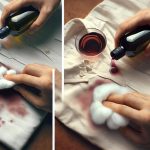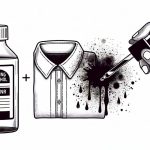To remove paint from corduroy, first identify if it’s water- or oil-based. Blot fresh paint gently without rubbing, then use cold water mixed with mild detergent for cleaning. For dried acrylic paint, carefully scrape excess, apply rubbing alcohol, and blot. Oil-based paint may need turpentine, used cautiously after testing a hidden spot. Always avoid harsh scrubbing to protect corduroy’s texture. Proper care and stain treatment extend its life—explore more detailed methods to restore your fabric fully.
Table of Contents
Key Takeaways
- Identify paint type (water-based or oil-based) to choose the correct cleaning method for corduroy fabric.
- Blot fresh paint spills gently and remove excess paint with a dull knife without rubbing or spreading.
- For dried acrylic paint, scrape gently, then dab with rubbing alcohol and a soft brush before rinsing and laundering.
- For dried oil-based paint, test turpentine on a hidden area, blot the stain carefully, rinse, and apply mild detergent.
- Wash corduroy in cold water on gentle cycle or hand wash, air dry flat, and brush ribs softly after drying.
Identifying the Type of Paint on Corduroy
How can you effectively remove paint from your corduroy if you don’t know what kind of paint you’re dealing with?
First, examine the paint’s texture and smell. Water-based paints, like acrylic or latex, usually feel soft and dry quickly, often with a mild odor. Oil-based paints tend to be thicker, take longer to dry, and have a stronger, solvent-like smell.
You can also check the paint container or label if available. If the paint is fresh, testing a small hidden area with water can help—water-based paint will soften or dissolve, while oil-based paint won’t.
Knowing the paint type is essential because it determines the cleaning method. Identifying it upfront saves you time and prevents damage to your corduroy fabric.
Immediate Steps to Take When Paint Spills on Corduroy
The first 10 minutes after paint spills on your corduroy are essential for preventing a permanent stain.
Quickly blot the area with a clean cloth or paper towel to absorb as much paint as possible. Avoid rubbing, as this can push paint deeper into the fabric’s fibers.
Blot paint spills immediately with a clean cloth; avoid rubbing to prevent deeper fabric stains.
Gently scrape off any excess paint using a dull knife or spoon, being careful not to damage the ribs of the corduroy. If the paint is still wet, try to prevent it from spreading by placing a piece of cardboard or thick paper underneath the fabric.
Keep the fabric flat and avoid folding or bunching it. Acting fast and carefully will give you the best chance to remove the paint before it sets.
Using Water and Mild Detergent for Fresh Paint Stains
If you catch the paint while it’s still fresh, acting quickly can make all the difference.
Use a mild detergent mixed with water to gently lift the stain without damaging the corduroy’s texture.
Make sure you apply the solution carefully and avoid rubbing too hard to protect the fabric’s ridges.
Immediate Stain Treatment
When you catch a paint stain on your corduroy fabric while it’s still fresh, act quickly to prevent it from setting.
First, gently blot the area with a clean cloth or paper towel to lift excess paint—don’t rub, as this can push paint deeper into the fibers.
Next, dampen a soft cloth with cold water mixed with a small amount of mild detergent. Carefully dab the stain, working from the edges inward to avoid spreading.
Continue blotting until the paint starts to loosen and lift. Rinse the fabric with cold water to remove detergent residue.
Repeat these steps if necessary, always handling the corduroy gently to preserve its texture. Quick, careful action here can save your fabric from a stubborn, permanent stain.
Choosing Gentle Detergents
Choosing the right detergent makes a big difference in removing fresh paint stains from corduroy without damaging its delicate texture. You’ll want to use a mild detergent specifically designed for delicate fabrics.
Harsh chemicals or strong detergents can break down the fabric fibers and ruin the soft ridges characteristic of corduroy. Mix a small amount of mild detergent with cold water to create a gentle cleaning solution.
Avoid bleach or aggressive stain removers, as they may discolor or weaken the fabric. Using just enough detergent guarantees you effectively lift the paint without leaving residue that can attract dirt later.
This careful choice protects your garment while tackling the stain, giving you the best chance to restore your corduroy’s original look.
Proper Cleaning Technique
Start by gently blotting the fresh paint stain with a clean cloth dampened in cold water mixed with a small amount of mild detergent.
Don’t rub—it can push the paint deeper into the corduroy fibers. Instead, focus on lifting the stain carefully.
Patience is key here; you want to:
- Avoid damaging the fabric’s delicate texture
- Prevent the stain from spreading further
- Retain the softness and appearance of your corduroy
- Minimize the use of harsh chemicals that may weaken fibers
- Save your favorite garment from permanent damage
After blotting, rinse the area with cold water to remove detergent residue.
Repeat this process as needed, and always air dry your fabric to avoid heat setting any remaining paint.
You’ll be surprised how effective this gentle cleaning technique can be!
Techniques for Removing Dried Acrylic Paint
Tackling dried acrylic paint on corduroy can be tricky, but with the right techniques, you can restore your fabric without damage.
Start by gently scraping off any excess paint using a dull knife or spoon. Then, apply a small amount of rubbing alcohol or acetone to a clean cloth and dab the stained area carefully, avoiding saturation. Let it sit for a few minutes to loosen the paint.
Next, use a soft-bristled brush to lift the paint particles from the fabric’s fibers. Rinse with cold water and blot dry.
If stains persist, repeat the process but avoid harsh scrubbing, which can damage corduroy’s texture. Finally, launder the fabric as usual, checking the stain before drying to prevent setting it permanently.
How to Treat Latex Paint on Corduroy Fabric
Although latex paint can be stubborn on corduroy, you can remove it effectively if you act quickly. Start by gently scraping off excess paint with a dull knife or spoon—be careful not to damage the fabric.
Latex paint can be tough on corduroy, but prompt, gentle scraping helps protect the fabric while removing excess paint.
Blot the stain with a clean cloth soaked in warm, soapy water to loosen the paint. You’ll want to:
- Use mild detergent to avoid harsh chemicals
- Dab, don’t rub, to prevent fabric damage
- Rinse with cold water after treatment
- Repeat the process if needed before drying
- Avoid heat until the stain is fully gone
If the stain persists, try applying a small amount of rubbing alcohol on a cloth and blot gently.
Acting fast and treating the stain carefully will save your corduroy’s texture and color.
Safe Methods to Remove Oil-Based Paint
When you find oil-based paint on your corduroy fabric, you need to act carefully to prevent damage.
First, gently scrape off any excess paint with a dull knife or spoon without pushing it deeper into the fibers.
Next, blot the stain with a cloth dipped in turpentine or mineral spirits—test on a hidden area first to verify it won’t discolor the fabric. Avoid rubbing; instead, dab gently to lift the stain.
After treating the paint, rinse the spot with cold water and apply a mild detergent directly to the stain. Let it sit for 10 minutes, then rinse thoroughly.
Finally, air dry the fabric away from direct heat or sunlight. Repeat carefully if necessary, but don’t use harsh chemicals that may ruin the corduroy texture.
Utilizing Commercial Paint Removers on Corduroy
If you decide to use commercial paint removers on your corduroy, choose products specifically designed for delicate fabrics to minimize damage.
Always test the remover on a hidden area first to guarantee it won’t discolor or weaken the fabric. Apply the remover gently with a soft cloth, avoiding harsh scrubbing.
Remember to work in a well-ventilated space and follow the product instructions carefully. Here’s what you should keep in mind:
- Pick removers labeled safe for delicate or natural fibers
- Avoid using bleach or harsh chemicals
- Use a cotton swab for precise application
- Rinse thoroughly after treatment to remove residue
- Pat dry, don’t wring, to preserve fabric texture
This approach helps you protect your corduroy while effectively tackling stubborn paint stains.
Tips for Hand Washing and Machine Washing Corduroy
Since corduroy requires gentle care to maintain its texture and appearance, you should approach hand washing and machine washing with specific techniques in mind.
When hand washing, use cold water and a mild detergent, gently agitating the fabric without scrubbing to avoid damaging the ribs. Rinse thoroughly to remove all soap.
For machine washing, always turn the garment inside out and select a delicate or gentle cycle with cold water. Avoid using bleach or harsh chemicals. Use a mild detergent designed for delicate fabrics.
After washing, don’t wring the fabric; instead, gently press out excess water. Lay the corduroy flat or hang it to air dry, keeping it away from direct sunlight or heat sources.
Following these tips helps preserve your corduroy’s look while effectively cleaning paint stains.
Preventing Damage to Corduroy’s Texture During Cleaning
To keep corduroy’s distinctive texture intact during cleaning, you’ll need to handle it with extra care. The fabric’s raised ribs can easily flatten or fray if treated roughly.
Here’s how to protect your corduroy while removing paint:
- Avoid scrubbing harshly; gently blot instead
- Use cold water to prevent shrinking or distortion
- Choose mild detergents without bleach or enzymes
- Let the fabric air dry flat, away from heat sources
- Brush the ribs softly with a clothes brush after drying
When to Seek Professional Cleaning Services for Paint Stains
When should you consider turning to professional cleaning services for paint stains on your corduroy?
If the paint is oil-based or has dried for more than 24 hours, tackling it yourself might cause more harm than good. Professionals have specialized solvents and techniques that can remove stubborn stains without damaging the fabric’s texture.
Also, if your corduroy item is valuable or has sentimental importance, it’s safer to rely on experts to avoid accidental damage.
When you’ve already tried home remedies without success, it’s a clear sign to call in pros.
Finally, if you’re unsure about the paint type or fabric care instructions, professional cleaners can assess and treat the stain appropriately, ensuring the best chance for a thorough and safe cleanup.
Frequently Asked Questions
Can Paint Stains on Corduroy Be Removed Without Water?
You can’t fully remove paint stains on corduroy without water, but you can try scraping off excess paint and using rubbing alcohol or paint thinner cautiously. Testing a small area first helps avoid damage.
How Long Should I Wait Before Attempting Paint Removal?
Think of paint as a setting sun—it’s best to act before it dips too low. You shouldn’t wait long; start removing paint as soon as it’s still wet for easier cleanup and better results.
Will Sunlight Affect Paint Stain Removal on Corduroy?
Sunlight can set paint stains, making them harder to remove. You shouldn’t expose the stained corduroy to direct sunlight before treating it. Instead, act quickly indoors to maximize your chances of successful paint removal.
Can Using Vinegar Help Remove Paint From Corduroy?
Like a potion in a wizard’s kit, vinegar can help break down paint stains on corduroy. You’ll want to dab it gently, avoid rubbing harshly, and rinse promptly for the best results.
Are Stain Protectors Effective on Corduroy Fabrics?
You’ll find stain protectors can be effective on corduroy by creating a barrier that repels liquids and prevents stains. Just remember to apply them properly and reapply regularly to keep your fabric looking fresh and clean.
- Does Chiffon Fabric Stink - July 15, 2025
- Does Chiffon Fabric Affect the Economy - July 15, 2025
- Does Cotton Fabric Have a Nap - July 15, 2025






